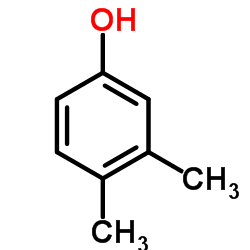3,4-Xylenol

3,4-Xylenol structure
|
Common Name | 3,4-Xylenol | ||
|---|---|---|---|---|
| CAS Number | 95-65-8 | Molecular Weight | 122.164 | |
| Density | 1.0±0.1 g/cm3 | Boiling Point | 226.9±0.0 °C at 760 mmHg | |
| Molecular Formula | C8H10O | Melting Point | 65-68 °C | |
| MSDS | Chinese USA | Flash Point | 94.0±7.2 °C | |
| Symbol |



GHS05, GHS06, GHS09 |
Signal Word | Danger | |
|
Use of Commercial Dry Yeast Products Rich in Mannoproteins for White and Rosé Sparkling Wine Elaboration.
J. Agric. Food Chem. 63 , 5670-81, (2015) In sparkling wines, mannoproteins released during yeast autolysis largely affect their final quality. This process is very slow and may take several months. The aim of this work was to study the effect of several commercial dry yeast autolysates on the chemic... |
|
|
Calculating virtual log P in the alkane/water system (log P(N)(alk)) and its derived parameters deltalog P(N)(oct-alk) and log D(pH)(alk).
J. Med. Chem. 48 , 3269-79, (2005) Growing interest in the use of both the logarithm of the partition coefficient of the neutral species in the alkane/water system (log P(N)(alk)) and the difference between log P(N)(oct) (the logarithm of the partition coefficient of the neutral species in the... |
|
|
Transdermal penetration behaviour of drugs: CART-clustering, QSPR and selection of model compounds.
Bioorg. Med. Chem. 15 , 6943-55, (2007) A set of 116 structurally very diverse compounds, mainly drugs, was characterized by 1630 molecular descriptors. The biological property modelled in this study was the transdermal permeability coefficient logK(p). The main objective was to find a limited set ... |
|
|
In silico and in vitro filters for the fast estimation of skin permeation and distribution of new chemical entities.
J. Med. Chem. 50 , 742-8, (2007) The development of in silico and in vitro tools to estimate or predict the passive human skin permeation and distribution of new chemical entities, useful in dermal drug delivery, in absorption studies of toxic compounds, and in the cosmetics industry, is pre... |
|
|
Defensive secretions of the carabid beetle Chlaenius cordicollis: chemical components and their geographic patterns of variation.
J. Chem. Ecol. 38(3) , 278-86, (2012) The defensive secretion of the ground beetle Chlaenius cordicollis is predominantly 3-methylphenol. Adult C. cordicollis were collected in Pennsylvania and Manitoba and induced to discharge defensive secretion in a vial. The headspace was sampled by solid pha... |
|
|
Aromatic effector activation of the NtrC-like transcriptional regulator PhhR limits the catabolic potential of the (methyl)phenol degradative pathway it controls.
J. Bacteriol. 177(6) , 1485-90, (1995) Pseudomonas putida P35X (NCIB 9869) metabolizes phenol and monomethylphenols via a chromosomally encoded meta-cleavage pathway. We have recently described a 13.4-kb fragment of the chromosome that codes for the first eight genes of the catabolic pathway and a... |
|
|
Location and organization of the dimethylphenol catabolic genes of Pseudomonas CF600.
Mol. Gen. Genet. 220(2) , 294-300, (1990) The gene organization of the phenol catabolic pathway of Pseudomonas CF600 has been investigated. This strain can grow on phenol and some methylated phenols by virtue of an inducible phenol hydroxylase and metacleavage pathway enzymes. The genes coding for th... |
|
|
Nucleotide sequence and functional analysis of the complete phenol/3,4-dimethylphenol catabolic pathway of Pseudomonas sp. strain CF600.
J. Bacteriol. 174(3) , 711-24, (1992) The meta-cleavage pathway for catechol is one of the major routes for the microbial degradation of aromatic compounds. Pseudomonas sp. strain CF600 grows efficiently on phenol, cresols, and 3,4-dimethylphenol via a plasmid-encoded multicomponent phenol hydrox... |
|
|
An aromatic effector specificity mutant of the transcriptional regulator DmpR overcomes the growth constraints of Pseudomonas sp. strain CF600 on para-substituted methylphenols.
J. Bacteriol. 176(24) , 7550-7, (1994) The pVI150 catabolic plasmid of Pseudomonas sp. strain CF600 carries the dmp system, which comprises the divergently transcribed dmpR gene and the dmp operon coding for the catabolic enzymes required for growth on (methyl)phenols. The constitutively expressed... |
|
|
Biodegradation of phenolic mixtures in a sequencing batch reactor. A kinetic study.
Environ. Sci. Pollut. Res. Int. 15(3) , 188-95, (2008) In this study, attention was focused on substituted phenols because of their widespread presence in industrial effluents originating from many different sources: they are major constituents of wastewater from coal conversion processes, coke ovens, petroleum r... |